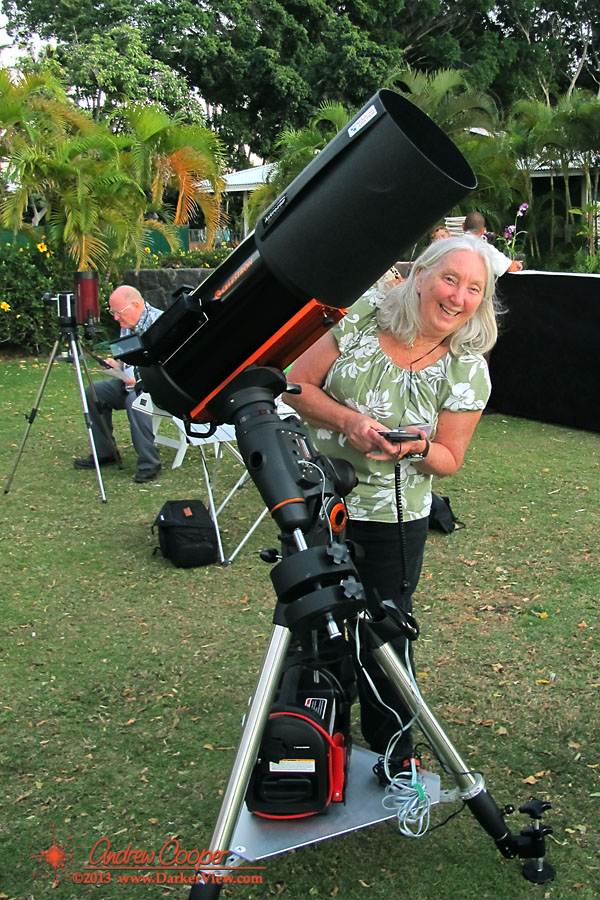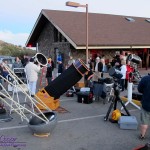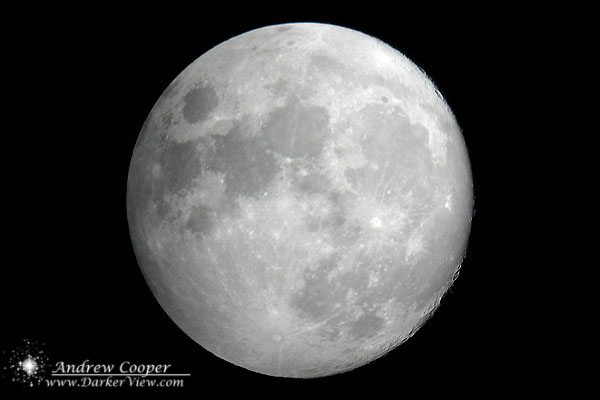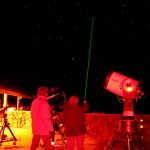
Tag: public
New Moon Saturday
A line of big telescopes greeted the crowd. Mike had his 20″, Cliff his 24″, my 18″ Deep Violet, later in the evening Olivier set up his 18″ Priscilla. All of this large glass was open to the public, we each had long line of folks waiting a turn at the eyepiece. It was a huge Saturday night crowd, several hundred people awaited darkness. Yes, I had made the decision to observe from the VIS, knowing that there would be a crowd, but wow!

Showpiece objects, the Andromeda Galaxy, The Pleiades and Jupiter were available for viewing. I was stuck on the Orion Nebula all evening long. I changed targets once, to meet a chorus of request to move back to the nebula. I have to admit it was a pretty view, even to me, who has seen this sight more times than I remember. I put the 35mm eyepiece in place, creating a bright low power view that had visitors waiting through line a few times for second and third looks.
In addition to the big dobs there were quite a few smaller ‘scopes present. Maureen had her C-11 setup, Larry brought his nice Stellarvue 102mm refractor, Mike had an 8″ SCT beside his 20″ for use by a friend. Dan didn’t bring a ‘scope, but he did bring pizza! We met Woody, an Alaskan Airlines pilot flying the Anchorage to Kona run. Out of a couple carry-on sized bags he produced more telescope than we would have thought fit in airline luggage…. A neat collapsible pier arrangement with an alt-az mount and a very nice WO 110mm APO.
Halloween Sidewalk Astronomy
For many years it has been my tradition to setup a telescope on Halloween. A tradition I have inherited from other amateur astronomers, a tradition I intend to continue.

Looking for an alternative to setting up in the driveway, as I have in the past, I instead arranged to setup at the King’s Shops in the resort at the bottom of the hill. The shops make an evening of it, with various entertainment and activities arranged for children and adults. Contacting the Kings Shops management I was able to arrange permission to set up a few telescopes for the evening.
Cliff and Maureen volunteered to join me, bringing more gear. We had a few other club folks drop by. Also helping out were Dean and Melinda Ketelsen, fellow Tucsonans who share the Halloween telescope tradition and happen to be visiting for the week.
Unfortunately clouds hampered us in the early evening. As usual these cleared as the night progressed so that by 8:30pm we had a mostly clear sky. Moonrise provided a beautiful view, followed by Jupiter. There was a steady flow of folks checking out the telescopes. Princesses, Batman, ninjas and more had views of Alberio, Andromeda and other celestial objects. A fun evening for everyone, mixing in just a bit of science education, just what sidewalk astronomy is all about.
Enjoying the Moonlight
Deb and I did a volunteer evening at the VIS last night. A great night with a great crowd, the sort of evening that defines the reason we continue to volunteer at the Mauna Kea VIS. Lots of great questions, great conversations and a little learning about the sky and Mauna Kea. As the southern cross hung above the slopes of Mauna Loa my green laser was busy pointing out constellations and bright stars.
The only real problem with the evening was the nearly full Moon hanging in the sky. The bright moonlight drowning out many of the deep sky objects we would normally view. Even bright objects like M13 were merely dim smudged in the eyepiece in place of the beautiful sights they offer under darker skies. With these conditions much of the telescope viewing was concentrated on the Moon and a beautiful planet Saturn.
One activity that is always a hit with a bright Moon partly makes up for the loss of dark sky viewing. I hold and quick course in introductory lunar photography using the afocal method. Show a few people how to take lunar photos and there is soon a line of people waiting at the refractor for their turn to try a few frames. A few hints and people are quickly taking great lunar shots, a photo and a memory to take home from the mountain.
The evening sped by quickly, spent in conversation with guests from the islands and from across the US. People ask about the sky as seen from different latitudes and locations. A few visitors from other countries add their perspective. It is often interesting to hear about other names for constellations or to learn bits of folklore from many other cultures.
So often the crowd disappears an hour after dark, driven off by the cold and wind. This night many didn’t go until it was time to shut down the telescopes. I guess they were not ready to end an enjoyable evening under moonlight.

Public Astronomy Laser Power and Safety
How bright a laser beam is needed to allow good public presentations and a good astronomy education experience? In the United States legal green lasers are limited to 5 milliwatts (mW) by the Food and Drug Administration. Many of the lasers sold as 5mW are actually 3-4mW as it is necessary to stay below that limit if you wish to import the laser into the United States or to sell the laser across state lines. 5mW units are fine if you are under fully dark skies, but often you are not, there are city lights, or moonlight and the 5mW beam ceases to be usably visible. This is worse if you are working with a larger group and the distance from the presenter is larger, also making the beam less visible. In practice I have found a beam in the 20-30mW range is about ideal. These lasers are available from a number of sources for around $100. Good visibility in moonlight, good visibility in light polluted surroundings and good large group utility. But importantly, not powerful enough to be truly dangerous.

How do I come up with the 20-30mW number as being relatively safe? Being an engineer I understand safety margins and over specification and figured there must be a compromise. The trick was to find undistorted data, without the bias of overcautious bureaucrats. The data is out there on the web, but took some digging to find, many medical journal articles are hidden behind subscription services. Fortunately there are sources like PubMed that are freely and publicly accessible. Eventually I found and read several very informative papers on lasers and eye damage, looked at pictures of laser damage on monkey retinas and looked a damage done by visible lasers in the same sort of power class as those available for public work. I was surprised by actual human damage studies, done on patients who were having eyes removed due to conditions like cancer, where the researcher could do damage without harming the patient. What I was looking for was just what level of laser radiation is dangerous in practical use.

A 20-30mW laser needs to be treated with respect as injury is possible, but no more than any other dangerous tool we use every day. In practice damage with a laser at a sensible power level (20-30mW) would require prolonged exposure (>0.5sec) on a single site on the retina, requiring staring into the beam. The bright green light would elicit both a blink response and an aversion of the head and eye, particularly in a visually dark adapted environment. I would strongly discourage use of any laser 50mW or greater for public astronomy work. Some of the references showed significant damage inflicted with 50mW lasers and sub second exposures. Lasers at all power levels should be kept out of the hands of anyone too young to understand the implications of the danger posed by a laser.
Retinopathy From a Green Laser Pointer, Dennis M. Robertson, MD; Jay W. McLaren, PhD; Diva R. Salomao, MD; Thomas P. Link, CRA, Arch Ophthalmology 2005;123:629-633 [Note: direct testing of a 5mW green laser pointer on a human subject]
Assessment of Alleged Retinal Laser Injuries, Martin A. Mainster, PhD, MD; Bruce E. Stuck, MS; Jeremiah Brown, Jr, MD, MS, Arch Ophthalmol. 2004;122:1210-1217. [Note: good general discussion on the issues of laser injury and great reference list]
